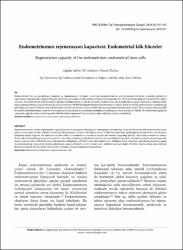| dc.contributor.author | Şahin, Çağdaş | |
| dc.contributor.author | Akdemir, Ali | |
| dc.contributor.author | Ulukuş, Murat | |
| dc.date.accessioned | 2016-10-19T07:56:20Z | |
| dc.date.available | 2016-10-19T07:56:20Z | |
| dc.date.issued | 2016 | |
| dc.identifier.citation | Sahin C, Akdemir A, Ulukus M. [Regeneration capacity of the endometrium: endometrial stem cells]. FNG & Bilim Tıp Transplantasyon Dergisi 2016;1(2):97-103. doi: 10.5606/fng.transplantasyon.2016.017 | en_US |
| dc.identifier.issn | 2149-441X | |
| dc.identifier.uri | https://hdl.handle.net/11446/1128 | en_US |
| dc.description | Ege Üniversitesi, Tıp Fakültesi | en_US |
| dc.description.abstract | Endometrium her ay gerçekleşen çoğalma ve dejenerasyon döngüsü nedeniyle postpubertal ve premenopozal dönemler arasında yüksek bir rejenerasyon kapasitesine sahiptir. Bu yapı içerisinde görev alan kök hücrelerin varlığına dair çalışmalar son 10 yıl içerisinde giderek artmıştır. Elde edilen sonuçlar endometriumda kök hücrelerin varlığını desteklemekte, ancak bu hücreleri tespit etmek için spesifik hücre yüzey belirteçleri hakkında daha fazla çalışmaya ihtiyaç duyulmaktadır. Bu süreç içerisinde, PDGFR-b (platelet derived growth factor receptor-beta) ve SUSD2 (sushi domain containing 2) gibi daha çok endometrial stromal kök hücrelere yönelik olmak üzere bazı spesifik hücre yüzey belirteçleri de saptanmıştır. Bu hücrelerin daha spesifik bir şekilde tanımlanmaları, nedenleri tam açıklanamamış birçok endometrial patolojinin anlaşılması için de yol gösterici olabilir. Bu veriler bize yapılacak çalışmalar ışığında endometrial kaynaklı kök hücrelerin rejeneratif tıpta kullanım alanı bulacağına işaret etmektedir. | en_US |
| dc.description.abstract | Endometrium has a high regenerative capacity between post-pubertal and pre-menopausal periods due to its proliferation and degeneration cycle which occur every month. Studies concerning the presence of stem cells that function in this structure have gradually increased in the last 10 years. Obtained results support the presence of stem cells in endometrium, but more studies are needed regarding specific cell surface markers to detect these cells. During this process, some specific cell surface markers, particularly related to endometrial stromal stem cells such as platelet derived growth factor receptor-beta (PDGFR-β) and sushi domain containing 2 (SUSD2), were also determined. Defining these cells more specifically may be a guide in understanding many endometrial pathologies, causes of which could not have been clarified exactly. In light of further studies, these data indicate that endometrial-derived stem cells will find utilization area in regenerative medicine. | en_US |
| dc.language.iso | tur | en_US |
| dc.publisher | Regeneration capacity of the endometrium: endometrial stem cells | en_US |
| dc.identifier.doi | 10.5606/fng.transplantasyon.2016.017 | en_US |
| dc.rights | info:eu-repo/semantics/openAccess | en_US |
| dc.subject | endometrium | en_US |
| dc.subject | menstrüasyon | en_US |
| dc.subject | rejenerasyon | en_US |
| dc.subject | kök hücre | en_US |
| dc.subject | endometrium | en_US |
| dc.subject | menstruation | en_US |
| dc.subject | regeneration | en_US |
| dc.subject | stem cell | en_US |
| dc.title | Endometriumun rejenerasyon kapasitesi: Endometrial kök hücreler | en_US |
| dc.title.alternative | Regeneration capacity of the endometrium: endometrial stem cells | en_US |
| dc.type | article | en_US |
| dc.relation.journal | İstanbul Bilim Üniversitesi Florence Nightingale Transplantasyon Dergisi | en_US |
| dc.department | DBÜ | en_US |
| dc.identifier.issue | 2 | |
| dc.identifier.volume | 1 | |
| dc.identifier.startpage | 97 | |
| dc.identifier.endpage | 103 | |
| dc.contributor.authorID | TR162036 | en_US |
| dc.contributor.authorID | TR135216 | en_US |
| dc.contributor.authorID | TR111268 | en_US |
| dc.relation.publicationcategory | Belirsiz | en_US |


















